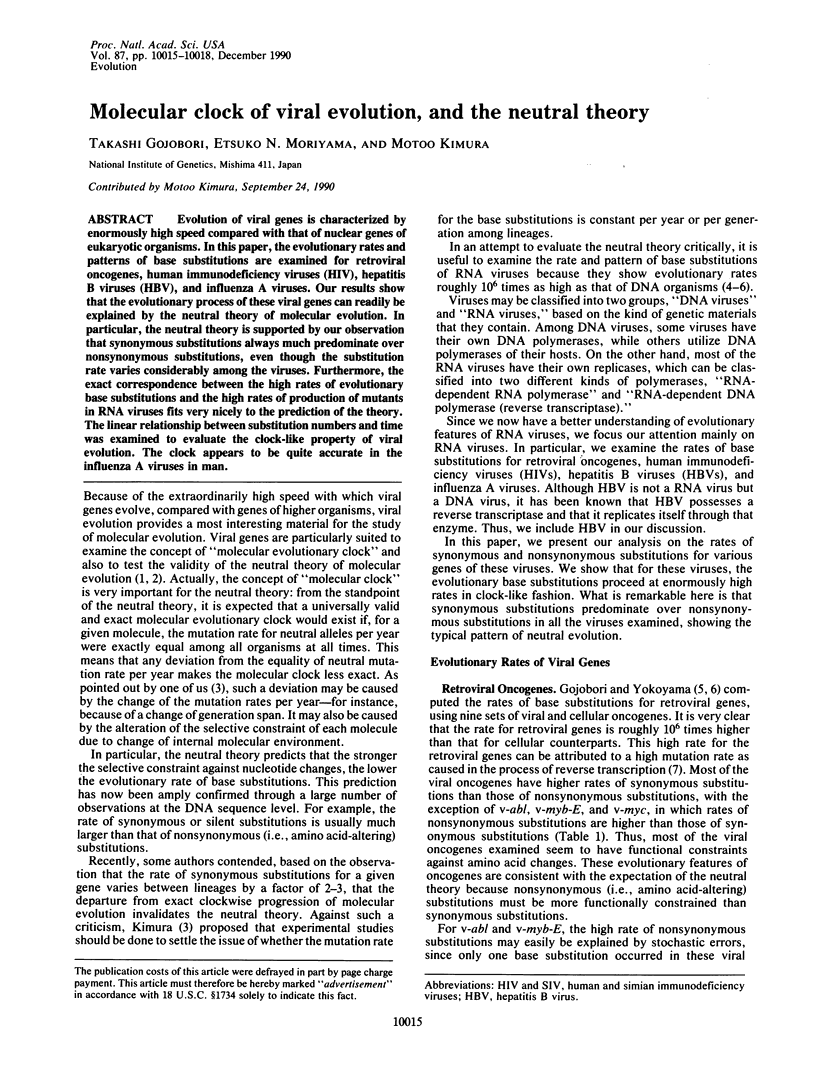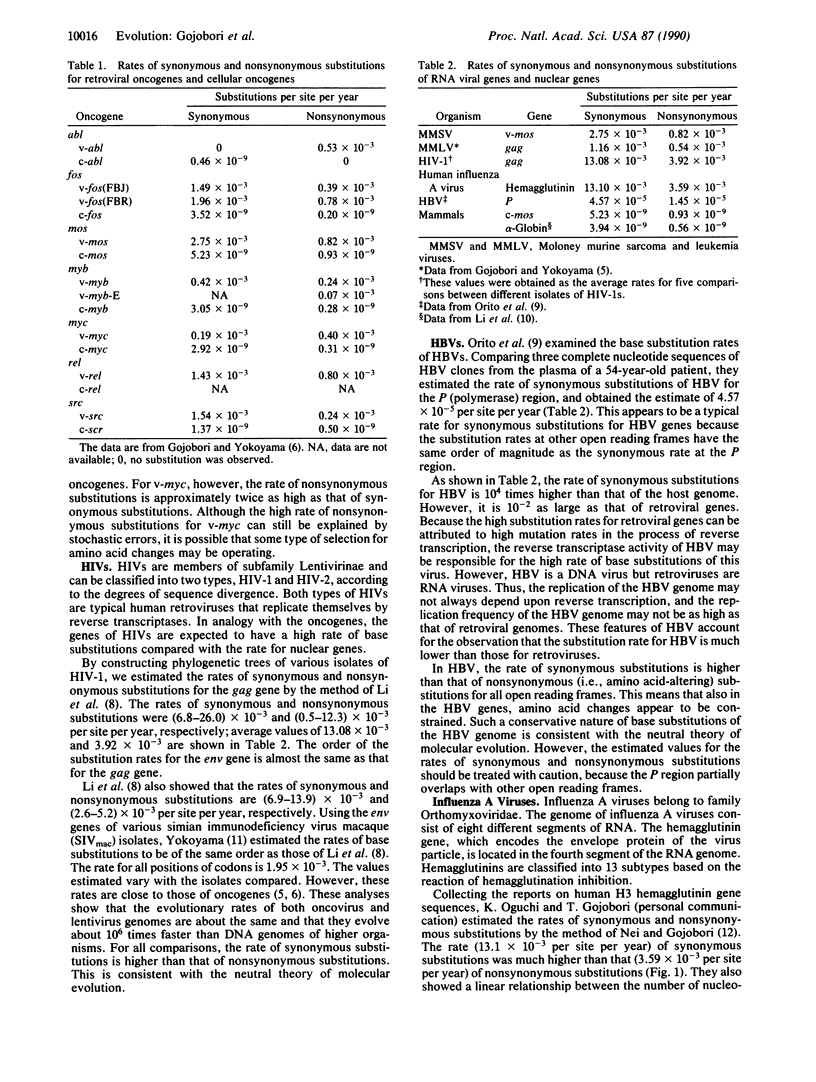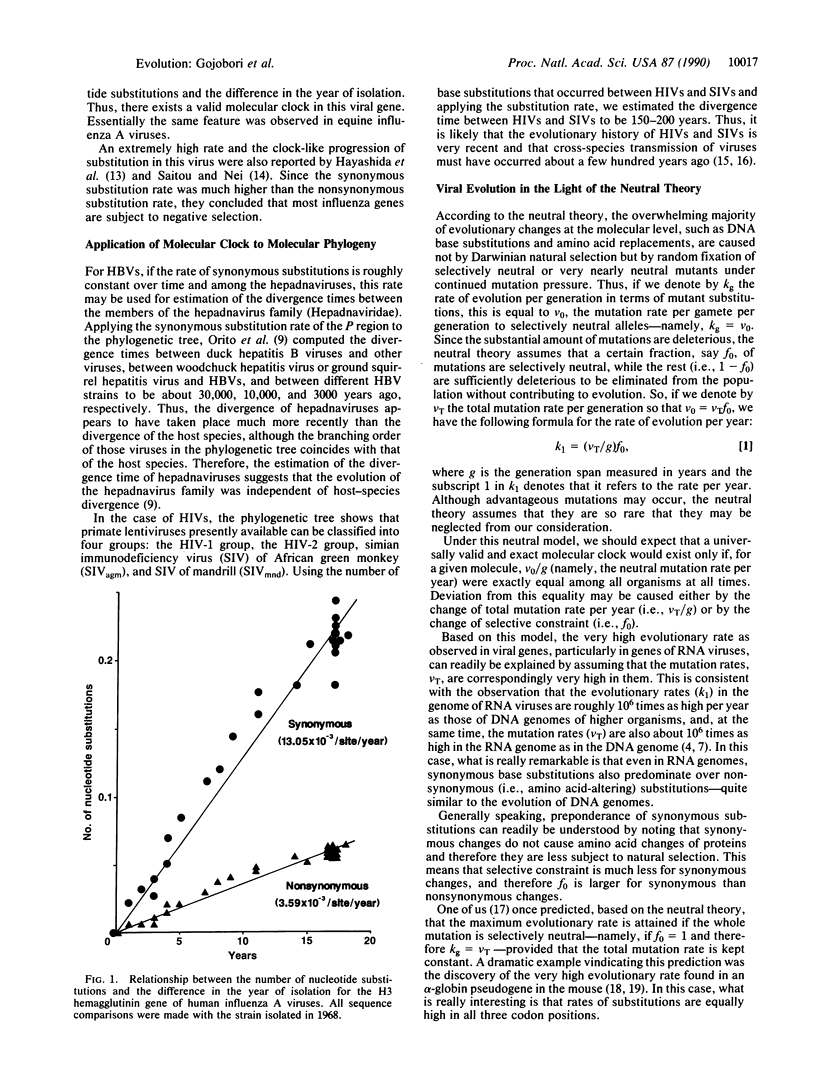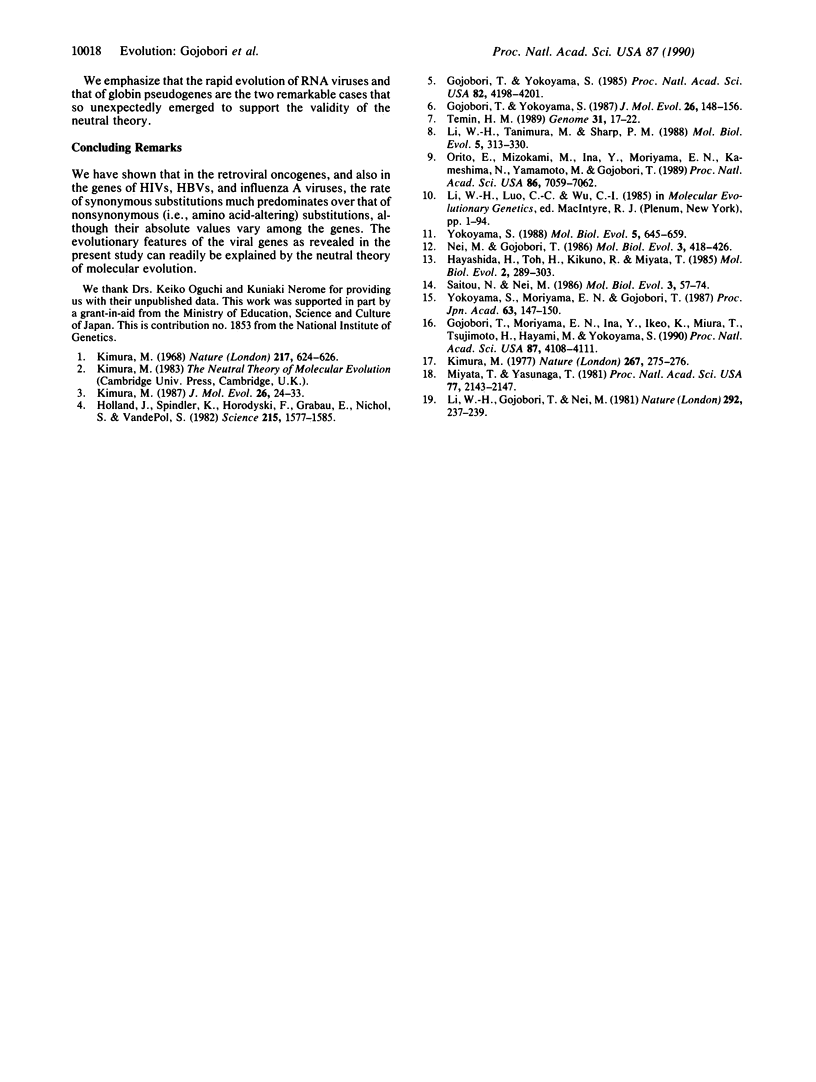Abstract
Evolution of viral genes is characterized by enormously high speed compared with that of nuclear genes of eukaryotic organisms. In this paper, the evolutionary rates and patterns of base substitutions are examined for retroviral oncogenes, human immunodeficiency viruses (HIV), hepatitis B viruses (HBV), and influenza A viruses. Our results show that the evolutionary process of these viral genes can readily be explained by the neutral theory of molecular evolution. In particular, the neutral theory is supported by our observation that synonymous substitutions always much predominate over nonsynonymous substitutions, even though the substitution rate varies considerably among the viruses. Furthermore, the exact correspondence between the high rates of evolutionary base substitutions and the high rates of production of mutants in RNA viruses fits very nicely to the prediction of the theory. The linear relationship between substitution numbers and time was examined to evaluate the clock-like property of viral evolution. The clock appears to be quite accurate in the influenza A viruses in man.
Full text
PDF



Selected References
These references are in PubMed. This may not be the complete list of references from this article.
- Gojobori T., Moriyama E. N., Ina Y., Ikeo K., Miura T., Tsujimoto H., Hayami M., Yokoyama S. Evolutionary origin of human and simian immunodeficiency viruses. Proc Natl Acad Sci U S A. 1990 Jun;87(11):4108–4111. doi: 10.1073/pnas.87.11.4108. [DOI] [PMC free article] [PubMed] [Google Scholar]
- Gojobori T., Yokoyama S. Molecular evolutionary rates of oncogenes. J Mol Evol. 1987;26(1-2):148–156. doi: 10.1007/BF02111288. [DOI] [PubMed] [Google Scholar]
- Gojobori T., Yokoyama S. Rates of evolution of the retroviral oncogene of Moloney murine sarcoma virus and of its cellular homologues. Proc Natl Acad Sci U S A. 1985 Jun;82(12):4198–4201. doi: 10.1073/pnas.82.12.4198. [DOI] [PMC free article] [PubMed] [Google Scholar]
- Hayashida H., Toh H., Kikuno R., Miyata T. Evolution of influenza virus genes. Mol Biol Evol. 1985 Jul;2(4):289–303. doi: 10.1093/oxfordjournals.molbev.a040352. [DOI] [PubMed] [Google Scholar]
- Holland J., Spindler K., Horodyski F., Grabau E., Nichol S., VandePol S. Rapid evolution of RNA genomes. Science. 1982 Mar 26;215(4540):1577–1585. doi: 10.1126/science.7041255. [DOI] [PubMed] [Google Scholar]
- Kimura M. Evolutionary rate at the molecular level. Nature. 1968 Feb 17;217(5129):624–626. doi: 10.1038/217624a0. [DOI] [PubMed] [Google Scholar]
- Kimura M. Molecular evolutionary clock and the neutral theory. J Mol Evol. 1987;26(1-2):24–33. doi: 10.1007/BF02111279. [DOI] [PubMed] [Google Scholar]
- Kimura M. Preponderance of synonymous changes as evidence for the neutral theory of molecular evolution. Nature. 1977 May 19;267(5608):275–276. doi: 10.1038/267275a0. [DOI] [PubMed] [Google Scholar]
- Li W. H., Gojobori T., Nei M. Pseudogenes as a paradigm of neutral evolution. Nature. 1981 Jul 16;292(5820):237–239. doi: 10.1038/292237a0. [DOI] [PubMed] [Google Scholar]
- Li W. H., Tanimura M., Sharp P. M. Rates and dates of divergence between AIDS virus nucleotide sequences. Mol Biol Evol. 1988 Jul;5(4):313–330. doi: 10.1093/oxfordjournals.molbev.a040503. [DOI] [PubMed] [Google Scholar]
- Miyata T., Yasunaga T., Yamawaki-Kataoka Y., Obata M., Honjo T. Nucleotide sequence divergence of mouse immunoglobulin gamma 1 and gamma 2b chain genes and the hypothesis of intervening sequence-mediated domain transfer. Proc Natl Acad Sci U S A. 1980 Apr;77(4):2143–2147. doi: 10.1073/pnas.77.4.2143. [DOI] [PMC free article] [PubMed] [Google Scholar]
- Nei M., Gojobori T. Simple methods for estimating the numbers of synonymous and nonsynonymous nucleotide substitutions. Mol Biol Evol. 1986 Sep;3(5):418–426. doi: 10.1093/oxfordjournals.molbev.a040410. [DOI] [PubMed] [Google Scholar]
- Orito E., Mizokami M., Ina Y., Moriyama E. N., Kameshima N., Yamamoto M., Gojobori T. Host-independent evolution and a genetic classification of the hepadnavirus family based on nucleotide sequences. Proc Natl Acad Sci U S A. 1989 Sep;86(18):7059–7062. doi: 10.1073/pnas.86.18.7059. [DOI] [PMC free article] [PubMed] [Google Scholar]
- Saitou N., Nei M. Polymorphism and evolution of influenza A virus genes. Mol Biol Evol. 1986 Jan;3(1):57–74. doi: 10.1093/oxfordjournals.molbev.a040381. [DOI] [PubMed] [Google Scholar]
- Temin H. M. Retrovirus variation and evolution. Genome. 1989;31(1):17–22. doi: 10.1139/g89-007. [DOI] [PubMed] [Google Scholar]
- Yokoyama S. Molecular evolution of the human and simian immunodeficiency viruses. Mol Biol Evol. 1988 Nov;5(6):645–659. doi: 10.1093/oxfordjournals.molbev.a040520. [DOI] [PubMed] [Google Scholar]


